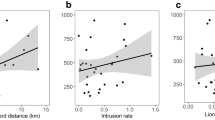Abstract
Mitani and Rodman (1979) showed that a simple measure of the defendability of the range area could differentiate fairly successfully between territorial and non-territorial species of primates. Their analysis has, however, been much criticised on the grounds that it considered only the day journey length and the diameter of the range area. We develop a number of more realistic indices of territory defendability that take into account both the length of the boundary to be defended and the detection distance as well as linear measures of range size. These indices (a) discriminate between territorial and non-territorial species more successfully than the Mitani-Rodman index and (b) allow the results to be extended to species which do not forage in cohesive groups. However, our results suggest that the Mitani-Rodman analysis was in many ways correct.
Similar content being viewed by others
References
Aldrich-Blake FPG, Bunn T, Dunbar RIM, Headley PM (1971) Observations on baboons, Papio anubis, in an and habitat in Ethiopia. Folia Primatol 15:1–35
Altman SA, Altmann J (1970) Baboon ecology. Chicago University Press, Chicago
Boesch C, Boesch H (1989) Hunting behaviour of wild chimpanzees in the Tai National Park. Am J Phys Anthropol 78:547–573
Cheney DL (1987) Interactions and relationships between groups. In: Smuts BB, Cheney DL, Seyfarth RM, Wrangham RW, Struhsaker TT (eds) (1987) Primate societies. Chicago University Press, Chicago, pp 267–281
Clarke MR (1983) Infant-killing and infant disappearance following male takeovers in a group of free-ranging howling monkeys (Alouatta palliata) in Costa Rica. Am J Primatol 5: 241–247
Davidge C (1978) Ecology of baboons (Papio ursinus) at Cape Point. Zool Afr 13:329–350
DePew LA (1983) Ecology and behaviour of baboons (Papio anubis) in the Shai Hills Game Production Reserve, Ghana. MSc thesis, Cape Coast University, Ghana
Dunbar RIM, Dunbar P (1974a) Ecology and population dynamics of Colobus guereza in Ethiopia. Folia Primatol 21:188–209
Dunbar RIM, Dunbar P (1974b) Ecological relations and niche separation between sympatric terrestrial primates in Ethiopia. Folia Primatol 21:36–60
Estrada A (1982) Survey and census of howler monkeys (Alouatta palliata) in the rain forest of “Los Tustlas”, Veracruz, Mexico. Am J Primatol 2:363–372
Goodall J (1965) Chimpanzees of the Gombe Stream Reserve. In: DeVore I (ed) Primate behaviour. Holt Rinehart and Winston, New York, pp 425–473
Goodall J (1986) The Gombe chimpanzees. Harvard University Press, Harvard
Harding RSO (1976) Ranging patterns of a troop of baboons (Papio anubis) in Kenya. Folia Primatol 25:143–185
Harvey PH, Pagel M (1991). The comparative method in evolutionary biology. Oxford University Press, Oxford
Hill CM (1991) A study of territoriality in Cercopithecus diana: do females take an active part in territorial defence? PhD thesis, University of London
Iwamoto T, Dunbar RIM (1983) Thermoregulation, habitat quality and the behavioural ecology of gelada baboons. J Anim Ecol 52:357–366.
Martin RD (1981) Field studies of primate behaviour. Symp Zool Soc Lond 46:287–336
Milton K (1980) The foraging strategies of howler monkeys. Columbia University Press, New York
Mitani JC, Rodman P (1979) Territoriality: the relation of ranging pattern and home range size to defendability, with an analysis of territoriality among primate species: Behav Ecol Sociobiol 5:241–251
Nishida T (1968) The social group of wild chimpanzees in the Mahali Mountains. Primates 19:167–224
Nishimura A, Fonseca GAB da, Mittermeier RA, Young AL, Strier KB, Valle CMC (1988) The muriqui, genus Brachyteles. In: Mittermeier RA, Rylands AB, Coimbra-Filho A, Fonseca GAB da (eds) Ecology and behaviour of Neotropical primates, vol. 2. World Wildlife Fund, Washington D.C., pp 577–610
Oates JF (1977) The social life of a black-and-white colobus monkey, Colobus guereza. Z. Tierpsychol 45:1–60
Rowell TE (1966) Forest-living baboons in Uganda. J Zool Lond 147:344–354
Sharman M (1981) Feeding, ranging and social organisation of the Guinea baboon. PhD thesis, University of St Andrews
Smuts BB, Cheney DL, Seyfarth RM, Wrangham RW, Struhsaker TT (eds) (1987) Primate societies. Chicago University Press, Chicago
Stoltz LP, Saayman GS (1970) Ecology and behaviour of baboons in the Transvaal. Ann Transvaal Mus 26:99–143
Waser PM (1976) Cercocebus albigena: site attachment, avoidance and intergroup spacing. Am Nat 110:911–935
Wrangham RW (1979) On the evolution of ape social systems. Soc Sci Inform18:335–368
Wrangham RW (1986) Ecology and social relationships in two species of chimpanzees. In: Rubenstein DI, Wrangham RW (eds) Ecological aspects of social evolution. Princeton University Press, Princeton, pp 352–378
Author information
Authors and Affiliations
Rights and permissions
About this article
Cite this article
Lowen, C., Dunbar, R.I.M. Territory size and defendability in primates. Behav Ecol Sociobiol 35, 347–354 (1994). https://doi.org/10.1007/BF00184423
Received:
Accepted:
Issue Date:
DOI: https://doi.org/10.1007/BF00184423




